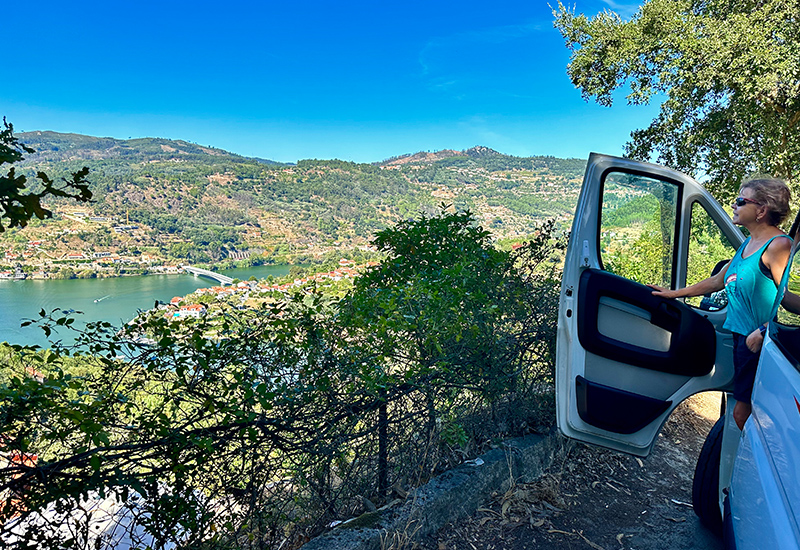Portugal offers many treasures prone to accolades, whether magnificent buildings, traditional stone villages or majestic views. But, when I heard about a stretch of road in the north of the country, considered the ‘most beautiful in the world’, I pricked up my ears. It had to be tested!
We are talking about National Road 222, which follows the Douro River for 226.3 km from Vila Nova de Gaia, on the outskirts of Porto, to Almendra near the Spanish border. Even before setting out on my journey, I learned it crosses three UNESCO World Heritage sites: the Porto riverside area, the wine region of Alto Douro, and the rock engravings at Vale do Côa.
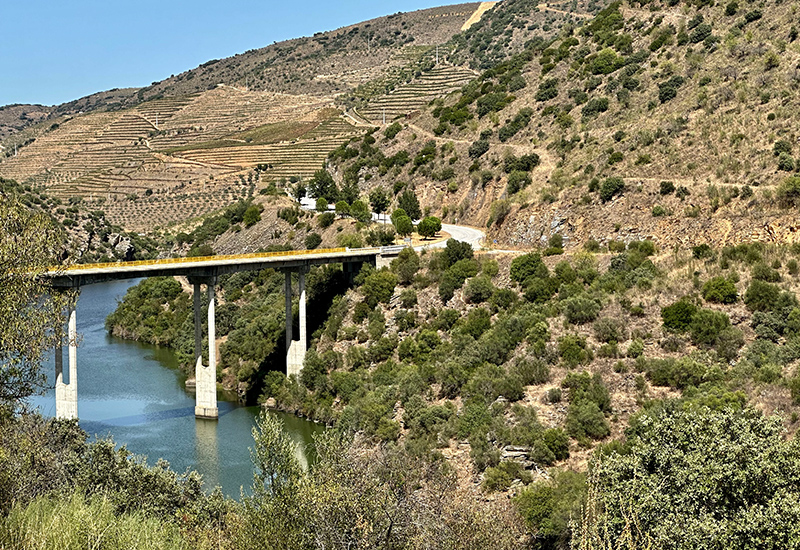
From Mafamude in the centre of Gaia, we set off on our quest in our trusted campervan. Navigating the traffic, we eventually found the zero km point near the island of Santo Ovídio, but from there, it was plain sailing. We drove through the town of Avintes. If you are thinking of lunch at this stage, stop to buy the famous broa de Avintes, a farmhouse bread with a long tradition in the north of the country. Having left the urban landscape behind, we soon encountered winding roads through hamlets, forested hillsides and distant mountain views.
Crossing the River Inha that joins the Douro, we had our first glimpse of the mighty river. Here, you find the first viewpoint along the route, Miradouro da Lomba, with its extensive views. Miradouro acquires a fitting double meaning here as mirar means ‘to observe’. There are many opportunities to mirar the Douro along the way, making the journey unique.
We continued to pass through charming villages that no doubt harboured immense cultural wealth. Throughout history, lands were successively occupied by different peoples, including the Romans and the Arabs, who all left their mark.
We reached Castelo da Paiva, renowned for producing vinho verde (green wine). An extensive wine, gastronomy and artisan fair is held in the town in July. However, sampling the delicacies will have to wait until next time for us. Instead, we made our way to the Praia Fluvial de Bitetos. Enjoying lunch and watching boats and cruise ships chugging by was thoroughly relaxing.
Cinfães, our next stop, deserves a visit for its history and cultural heritage. It’s linked to the Knights Templars who owned fortresses here, such as Torre da Chã and numerous interesting Romanesque churches. The town is also connected to Afonso Henriques, the first King of Portugal.
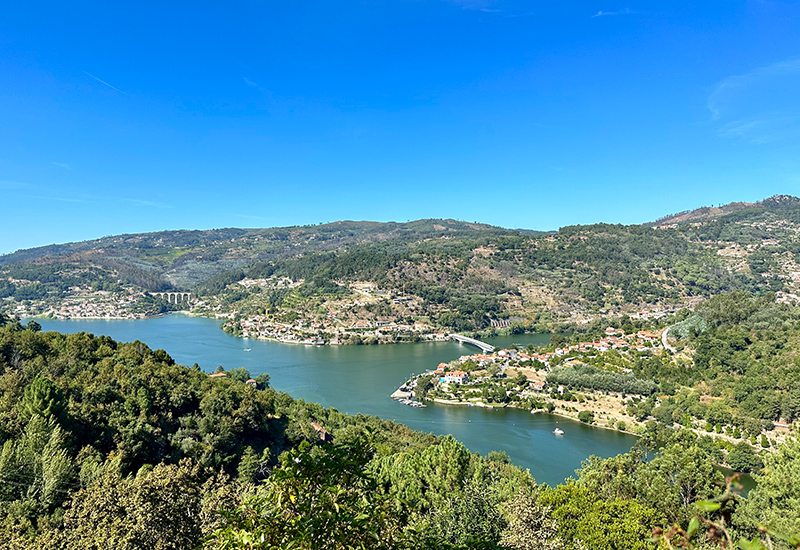
While it is difficult to visit all the miradouros (viewpoints), it is worth making a detour to Miradouro de Teixeirô, regarded as one of the most impressive viewpoints. Overlooking the Douro River at the mouth of the Bestanca River, it offers a unique view over the Old Port, once an important stopping point for the traditional wooden rabelo boats on their way to the Vila Nova de Gaia docks. You can also see the impressive arched railway bridge, Ponte de Pala, on the other side of the river, where the river reaches its highest flow. The scenery is picture postcard perfect.
We snaked our way along the river to reach Resende, which also has its claim to fame – apart from a rich architectural heritage, it boasts delicious cherries. Here, the terraces of the Douro are decorated with cherry groves and countless trails of the Romanesque Route.
Peso da Régua is synonymous with port wine. It’s the oldest demarcated wine region in the world, created in 1756 by the Marques de Pombal. It’s on the undulating slopes of the Alto Douro Wine Valley, where the famous port wine is produced. The sheer beauty of the wavy patterns of the terraces, sometimes perched at seemingly impossible angles, almost takes your breath away. I can see why it was designated a UNESCO World Heritage Site. From here, the barrels of wine were transported for centuries in the rabelo boats to Vila Nova de Gaia, where the wine was aged in cellars. I’m beginning to understand the significance of the start of Route 222 at Gaia.
It is also the perfect destination for anyone wanting to learn about the history of Douro wines. You could visit the Douro Museum and Quinta do Vallado, which has a fantastic wine cellar. There is another viewpoint, São Leonardo de Galafura, nearby. If a cruise along the river Douro takes your fancy, this is an excellent place to embark.
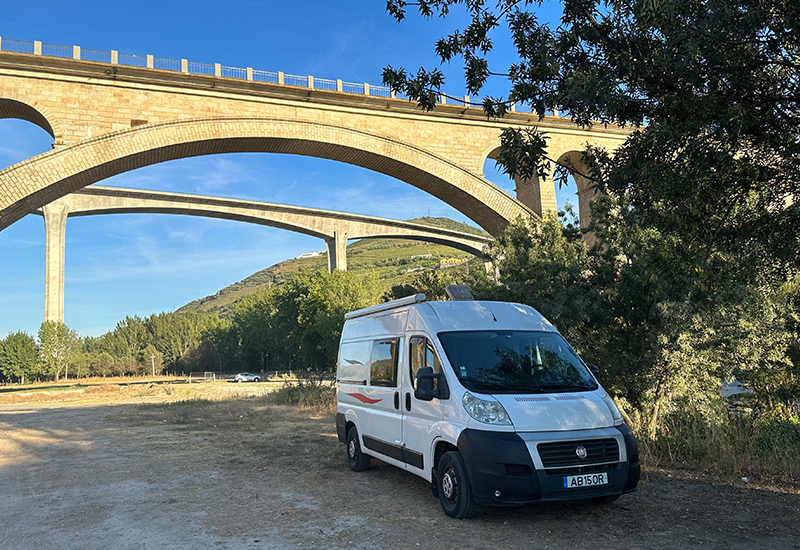
We had an overnight stopover in a designated space for campervans under the arches of two enormous bridges by the river. What better way to spend the night?
If you are curious about history, a 15-minute detour on the A23 to Lamego will be worth it. The city was central to the nation’s history from its Roman origins to the Christian Reconquest. It was here in 1139 that Afonso Henriques was declared Portugal’s first king and monuments of national reference can be visited.
The gem of Route 222 is undoubtedly the road between Peso da Régua and Pinhão. The 27-km stretch with 93 bends that follow the meandering river presents jaw-dropping vistas at each curve.
Avis has crowned this part of the EN222 as “the road that offers the best driving experience in the world for its location and the spectacular views it offers.” The campervan navigated the snaking, zigzagging road with great aplomb.
Five dams with enormous locks allow navigation along the Douro. We were fortunate to see one of the locks at the Régua dam in operation. A large cruise ship was approaching along the river. There was just enough room for the ship to manoeuvre the dam, which is 85 m long and just 12 m wide. With three mooring floats on both sides of the walls, the ship was lowered 27 m – quite a sight.
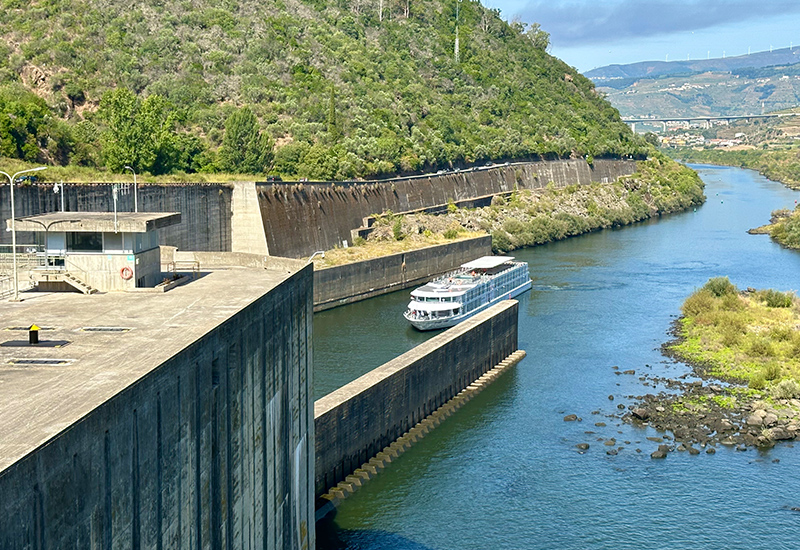
Located at the confluence of the Douro and Pinhão rivers lies the very pretty town of Pinhão. The surrounding terraces and the meticulously aligned vineyards create a unique pattern – a work of intricate art displayed right before you. We strolled along the riverfront, watching the cruise boats and the curved, flat-bottomed rabelo boats that sailed past regularly. They no longer transport barrels of port wine but tourists.
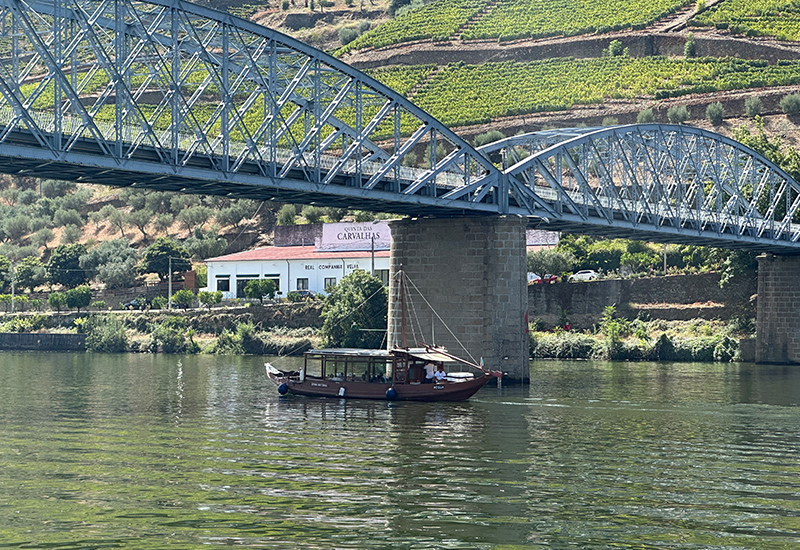
The arrival of the train in 1880 helped transport goods and people. The train station is a work of art in itself. The walls are covered with 24 panels of glazed tiles (azulejos) in shades of blue that depict the Douro landscape and enchanting scenes of the wine harvest.
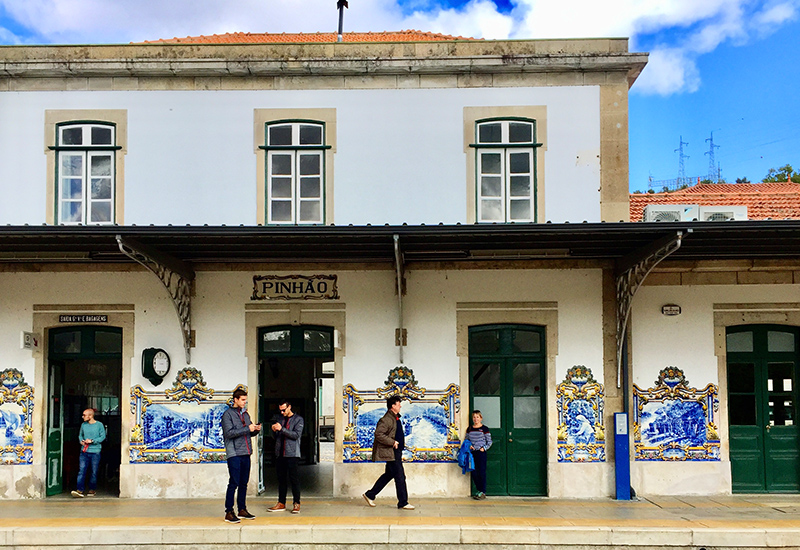
With more time, we could have embarked on a short train journey as I would have liked to experience the views of the river valley from different angles – a must for next time.
For me, the rest of the route to Almendra was equally spectacular but in a different way. We diverted from the river and drove through more arid regions, although still replete with vineyards, passing through the town of São João da Pesqueira, the oldest recognised municipality in Portugal, created in 1055.
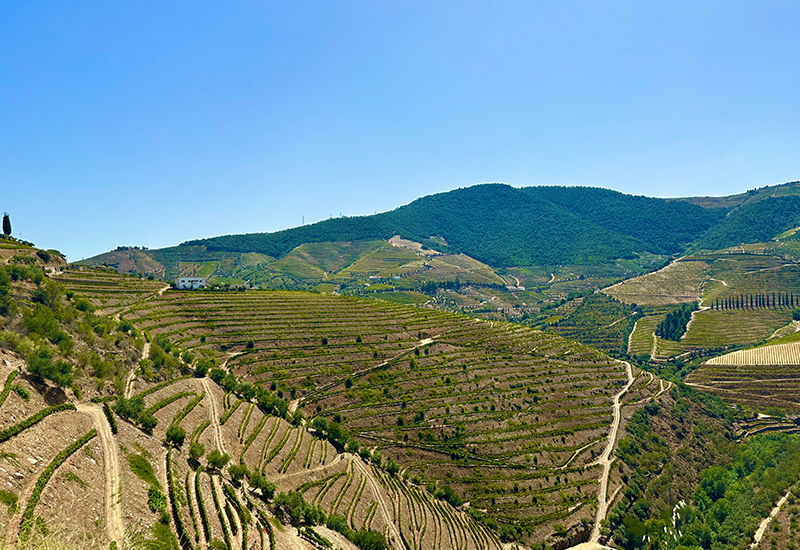
If one hasn’t had a fill of miradouros yet, a detour on the NE222-3 takes you to one of the most famous viewpoints of São Salvador do Mundo, where the sanctuary stands out with its small chapels. You can glimpse the Valeira Dam and, in the background, the Douro railway.
Continuing the detour, you can visit the small schist village of São Xisto overlooking the Douro. It is well preserved and now dedicated to rural tourism.
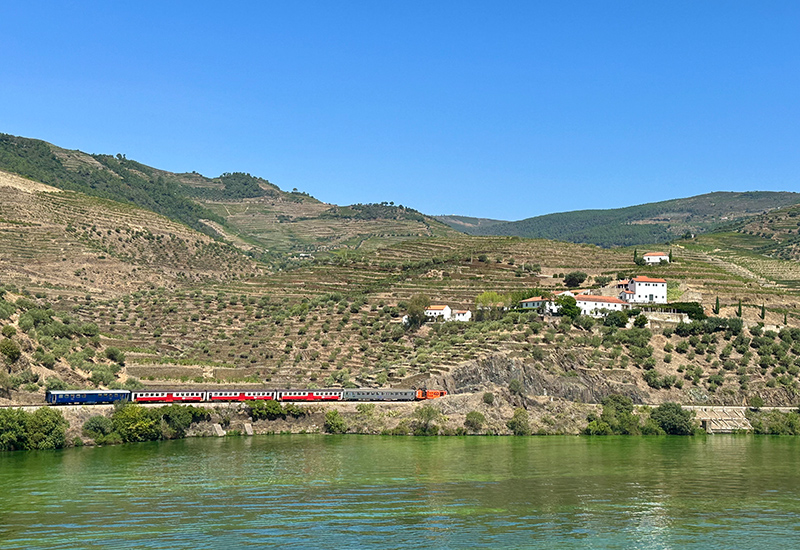
On our last lap on the EN222, the vineyards started to give way to olive and almond cultivations. We bypassed the city of Vila Nova de Foz Côa, although there is an interesting museum, Museu de Côa, to be visited for anyone willing to take the detour.
Our final destination at Almendra had been reached! We proudly posed at the tall granite sign proclaiming that 222 km of NE 222 had been covered. The many stickers on the sign indicated that quite a few had achieved the same feat.
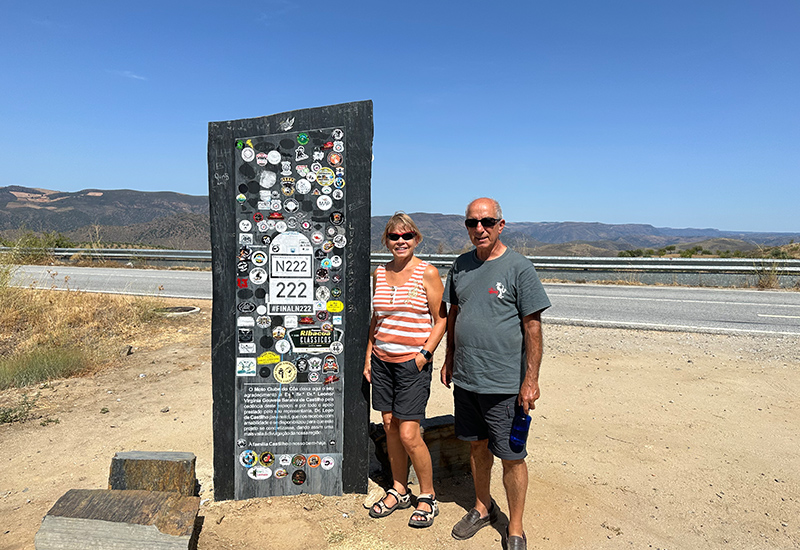
Before saying goodbye to the route, one more thing remained to be done. A visit to the Côa Valley Archaeological Park, an open-air Palaeolithic site. Amongst its riches are thousands of engraved rock drawings of animal and human figures. Because of its rareness and extension, it was declared a UNESCO World Heritage Site in 1998.
For us, this visit became another ‘next time’. In the mid-August heat, the site was closed, but we had a taster in the museum and could view drawings and maps.
At the end of the journey, I had to answer the question posed at the start. Is it the most beautiful stretch of road in the world? It was an amazing journey that I wholeheartedly recommend. Perhaps it’s not the most beautiful in the world, but it most certainly takes your breath away.
What’s the best time of year to undertake the journey? I wouldn’t recommend the height of summer. It was hot! The best time might be in the autumn when the harvests are made. Alternatively, April and May are optimum as the weather is amenable, and the spring colours enhance the experience. Take your time and make detours to fully appreciate what the Douro offers.
